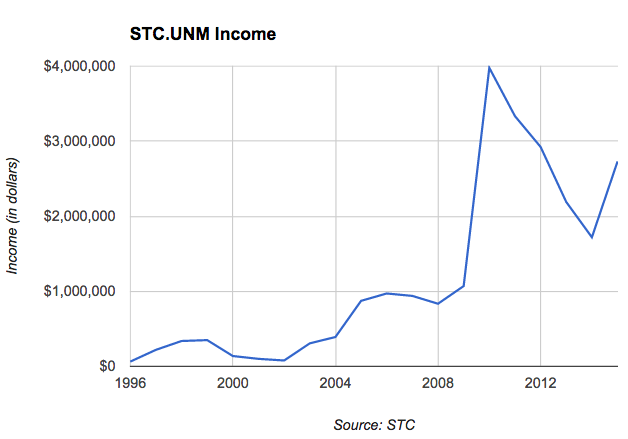[vc_row][vc_column][vc_column_text]
STC income rises this year for first time since 2010 but UNM Technology Transfer CEO says the fluctuating income is normal.
Despite revenue declines in the last four years, 2015 brings a million dollar boost to income for STC.UNM, formerly Science and Technology Corporation at UNM.
STC is responsible for taking technology invented at UNM and transferring it into the marketplace. It does this by either marketing the technology to existing companies or providing support for the inventor to start a business of his or her own.
STC’s yearly income reached a peak in 2010 at $3,976,373, according to metrics listed on its website. From 2010 to 2014 there was a yearly decrease in income. 2015 showed the first increase since 2010, rising from $1,718,949 the previous year to $2,729,547. The income numbers are comprised of licensing and patent reimbursement.
STC CEO Lisa Kuuttila said one invention was largely responsible for the increase in income beginning in 2010. A “patent that was used in semiconductor manufacturing for double patterning” caused both the spike and the gradual decrease in income, according to Kuuttila. This technology was invented by Steve Brueck, director of the School of Engineering’s Center for High Technology Materials at UNM. The patent eventually expired, leading to the decrease in income.
According to Brueck, STC’s involvement allowed his invention to fall in line with Moore’s Law. Moore’s Law states that the number of transistors in a computer chip will double roughly every two years.
“As Moore’s Law continues and things continue to get smaller, they need new techniques, and this double patterning is one of those techniques,” Brueck said. “It has allowed Moore’s Law to continue for the last several generations. So it’s in every chip you buy today.”
Although the income in years following 2010 were decreasing, Kuuttila said the data should be looked at relative to the rest of STC’s history. “We had quite a bit of income those three years before the patent expired and so if you don’t look at those three years in the absolute sense you can still see that the curve is going up in terms of our income.”
The fact that Brueck’s invention created the majority of STC’s income for 2010 and trickled onward is not out of the ordinary, according to Kuuttila. “Often times, there will be one or two inventions that generate a great deal of income for some period of time and then the patent expires, typically, so that’s not uncommon at all…It means we’re doing the right things because you’re going to have these spikes in income as we grow, but overall you want to be on an upward trajectory.”
Sometimes investments may take take a while to pay off, especially for medical inventions. A medical drug may take ten years to receive regulatory approvals and reach the market, according to Kuuttila.
Beyond the time it may take for an investment to start showing a return, the process of evaluating an invention can be difficult, according to Kuuttila. STC can’t simply judge the invention based on the current market. Sometimes an invention may create a market for itself, as was the case with gene splicing at Stanford and the University of California. “Ultimately it created an entirely new industry,” Kuuttila said.
Kuuttila was at Stanford when the gene splicing patent was filed. She thinks the technology would have been passed over if traditional marketing techniques were applied to its evaluation. “I caution people not to try to use tools that apply to existing markets quite well to early stage technologies because they just don’t apply,” Kuuttila said.
Kuuttila started at STC in 2003 after working at technology commercialization programs at Purdue University, University of Georgia, and Iowa State University.
From an inventor’s perspective, STC allows an individual or team to patent an invention and sell it to companies. “The idea is that faculty and students come up with processes that have some commercial value and in order to get protection for that value you go through STC to get patent protection. The patent protection allows you to market that technology to other companies,” Brueck said.
Outside of income, STC provides other benefits to UNM. Kuuttila claims their efforts help create jobs for graduates by creating companies from emerging technologies, as well as influencing faculty recruitment and retention.
Another goal of STC is to benefit the community it serves. “Of course, another important outcome is the ultimate economic impact on the community from the startups,” Kuuttila said. “So since we’re a public university, we really want to give back to the region that we’re in.”
[/vc_column_text][/vc_column][/vc_row]
